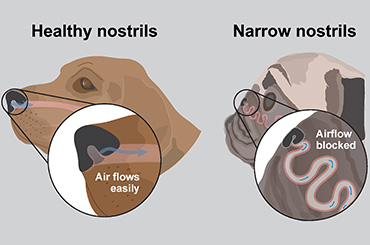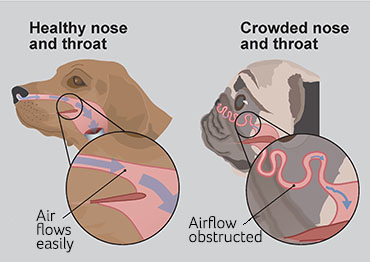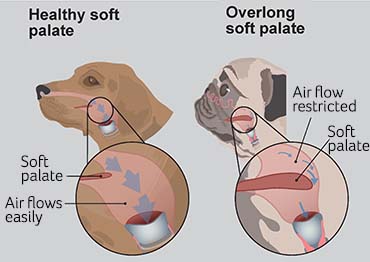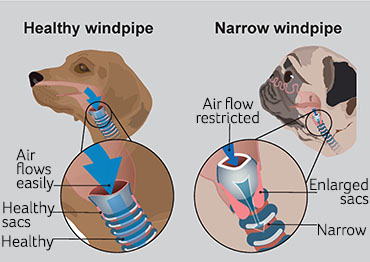What is Brachycephalic Obstructive Airway Syndrome?
Brachycephalic obstructive airway syndrome (BOAS) is a group of conditions that arise from the selective breeding of short-nosed dogs and cats, commonly known as brachycephalic breeds. Breeds such as Pugs, English Bulldogs, and French Bulldogs., can have certain anatomic abnormalities that can cause these respiratory difficulties. Brachycephalic breeds have intentionally been bred to shorten the length of their noses, and thus suffer from the consequential side effects of this breeding. Breeds with flattened noses have a compacted skeleton, resulting in multiple anatomical malformations to the breathing passages. Other common examples of Brachycephalic dog breeds include Pekingese and Boston Terriers. Persian cats are also a brachycephalic breed.
Conditions that comprise BOAS
Classically the syndrome consists of multiple components, though it should be noted that not all individuals will necessarily have all four components.
Stenotic Nares
Brachycephalic breeds have stenotic, or narrow, nares (nostrils) and nasal passages. This causes increased resistance to airflow through the nostrils and nasal passages resulting in an increased effort to breathe. This increased negative pressure in the back of the throat in turn results in stretching of the soft palate. Essentially, this is when the nostril openings are too small for the animal.
Elongated Soft Palate
The end of the palate, known as the soft palate, is the portion of the roof of the mouth that does not have any bone underneath and it is often both excessively lengthened and thickened in brachycephalic breeds. This fleshy tissue is drawn into the larynx during respiration and vibrates resulting in the classic snore or “stertor” made by brachycephalic breeds. This tissue can block the larynx reducing airflow to the lungs. Nearly all brachycephalic animals have an elongated soft palate and it is not always clinically significant. When it is a clinical problem, the excessive palate tissue causes some degree of obstruction in the upper airway.

|

|
|

|

|
Image source: https://www.pdsa.org.uk/pet-help-and-advice/pet-health-hub/conditions/boas-breathing-problems-in-flat-faced-dogs
Everted Laryngeal Saccules
Laryngeal saccules are two mounds of tissue that are located in front of the vocal folds in the larynx. (voice box). The saccules normally are positioned away from the airway opening but due to the vacuum associated with increased respiratory effort, the lining of the saccules can be pulled into the airway, closing it off further. These then block the opening to the airway further reducing airflow to the lungs.
Laryngeal Collapse
The larynx is a specialized structure that represents the opening of the trachea (windpipe). It allows air to flow into and out of the trachea and lungs during respiration. It also prevents food and water from entering the trachea when swallowing, lastly the vocal folds within the larynx allow dogs and cats to vocalize. Laryngeal collapse is an advanced form of brachycephalic airway syndrome that results from the weakening of the cartilage that supports the larynx. Without this support, the larynx collapses. This reduces airflow or completely prevents airflow to the lungs.
Gastrointestinal Problems
Brachycephalic breeds may also develop problems with the gastrointestinal system. These may include regurgitation and vomiting.
Diagnosis of BOAS
All brachycephalic breeds suffer from some degree of BOAS. The most common clinical history is noisy breathing, particularly on inspiration, with varying levels of respiratory distress. Less commonly, dogs may present with acute collapse following exercise or over-activity, or present with frequent regurgitation or vomiting.
Surgical Treatment
Brachycephalic obstructive airway syndrome is treated with partial resection of the soft palate (staphylectomy), nares, and laryngeal saccules. These procedures reduce the amount of tissue blocking the flow of air to the lungs and improve the quality of life of BOAS patients. Unfortunately, a complete cure for this condition is not possible. Subsequently, a mild degree of noise while breathing may be retained.
Important Details Regarding Surgery
This procedure requires specialized training to be able to perform. Although all surgery and anesthetics contain an inherent risk, it is important to highlight the possible risk associated with this procedure. Although these risks are there no matter who performs the procedure, the more experience the surgeon has, the more prepared they are at minimizing and dealing with complications. Most patients will go home the same day and, aside from being a little wobbly from anesthesia, there will be no noticeable issues. A majority of dogs will have noticeable improvement in their breathing within 24 hours post-surgery and continue to improve over the next 1-3 months. There is a small complication rate postoperatively of temporarily being noisier (1-2 weeks), needing additional medications (such as sedatives, antibiotics, and others), and possibly increased rechecks with the veterinarian. There are even smaller risks of severe complications requiring additional surgery in cases of severe BOAS. It is STRONGLY RECOMMENDED to do this procedure on young healthy dogs, preferably under a year of age, as they do not have the same increased risks.
You can view our Frequently Asked Questions About BOAS here. To book your initial pre-operative appointment or to find out more information about this condition and surgical procedures, please reach out to us at (209) 577-3481.
